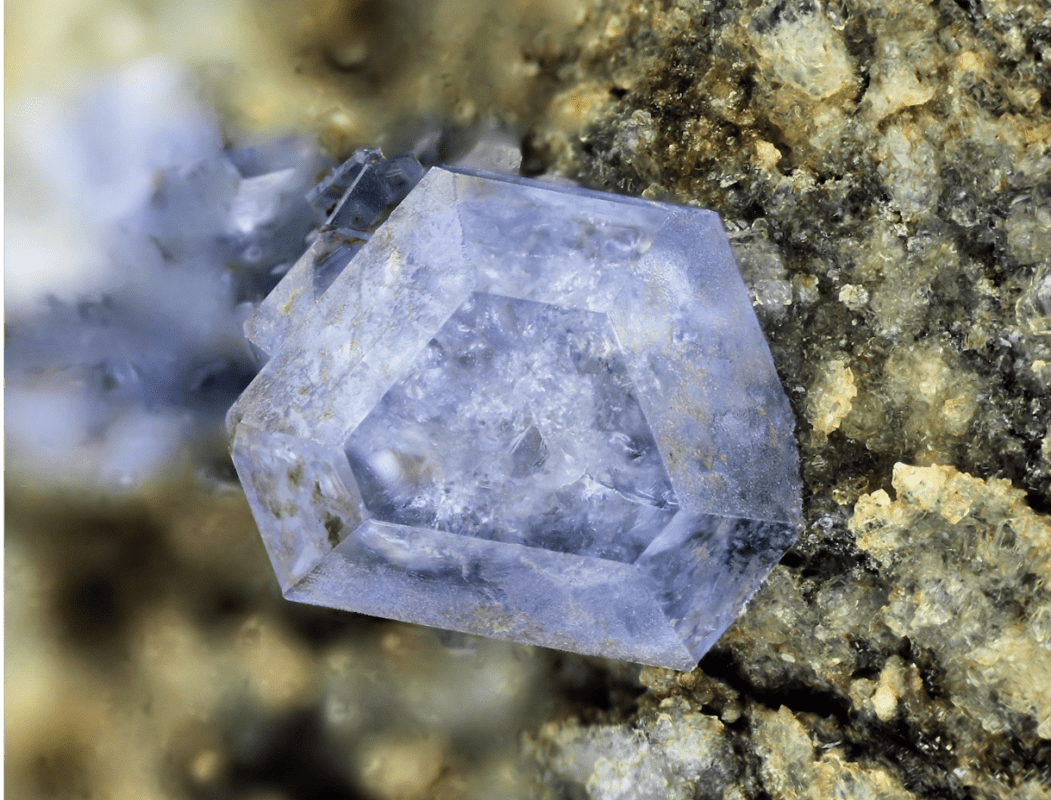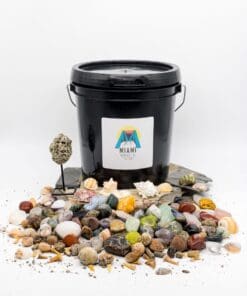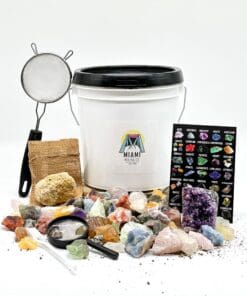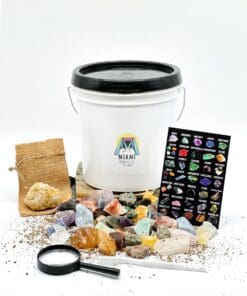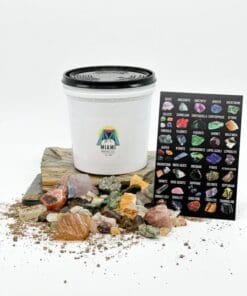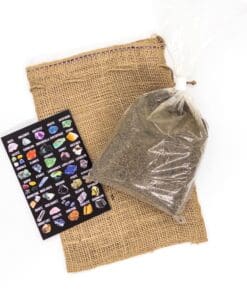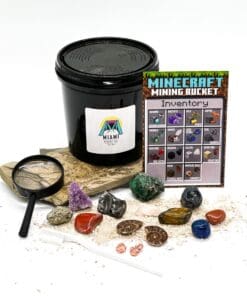California’s Gem Mining Secrets: Ultimate Gem Mining Guide
California, popularly known as the Golden State due to its gold rush history, is also a haven for gem enthusiasts. Its rich geology provides a playground for those eager to unearth dazzling gemstones and experience the thrill of discovery. This article delves deep into California’s gem mining world, detailing its history, the gems you can find, and the prime locations for these treasures. Let’s embark on this sparkling journey!
The Most Popular Gemstones in California
California’s diverse geology makes it one of the prime locations for a variety of gemstones, both common and rare. From the fiery hues of garnets to the icy clarity of quartz, the Golden State’s underground treasury is a treat for both casual collectors and seasoned gemologists. Here, we provide a more detailed breakdown of the gemstones you can find in California:
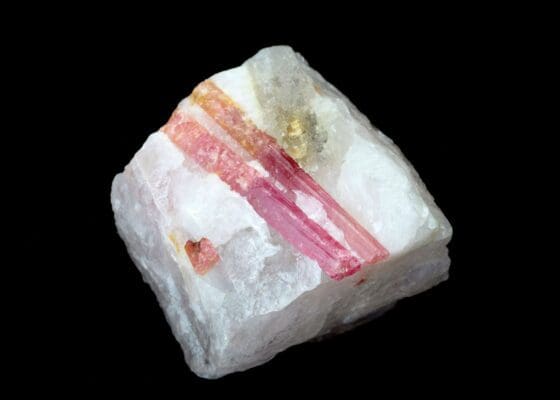

Rare Gemstones in California
| Gemstone | Description |
|---|---|
| Benitoite | A striking blue gemstone, benitoite is not only rare but also California’s state gem. It’s mostly found in San Benito County and is coveted for its unique color and crystal structure. |
| Pink Tourmaline | This lovely pink gem is particularly associated with San Diego County. The mines in this area once supplied the finest pink tourmalines to the Qing Dynasty of China. |
| Kunzite | A pinkish or lilac gem, kunzite is another stone predominantly found in San Diego County. Its transparency and color make it a sought-after gem for jewelry. |
| Black Jade | This variant of jade boasts a deep, dark color that distinguishes it from its greener cousins. California’s black jade deposits are mostly found along the state’s coastal regions. |
| Blue Garnet | Though garnets are commonly known for their red hue, the rarer blue garnet has been found in parts of California. Its color shift property, from green-blue in daylight to purplish-red under incandescent light, makes it truly special. |
Common Gemstones in California
| Gemstone | Description |
|---|---|
| Quartz | Abundantly found, quartz comes in various forms such as clear, smoky, and citrine. Its versatility makes it popular for various decorative and jewelry purposes. |
| Agate | With its swirling patterns and various colors, agate can be found in many regions of California, especially along the coastline. |
| Jasper | This opaque rock is known for its red, yellow, and brown shades. It’s often used for jewelry and ornamental purposes. |
| Garnet | Beyond the rarer blue garnet, more common red garnets are abundantly found, especially in the Sierra Nevada mountains. |
| Aquamarine | This blue to green-blue variety of beryl is found in various mountainous regions across the state. |
| Turquoise | With its distinct blue-green hue, turquoise has historically been used in jewelry and ornaments by Native Americans and continues to be popular today. |
| Gold | While more a metal than a gemstone, gold nuggets and flakes are still commonly found in California, a nod to its Gold Rush past. |
| Serentine | California’s state rock, serpentine has a waxy luster and can vary in color from green to black. |
| Chalcedony | A form of quartz, chalcedony is found in various shades and is often used for carvings and jewelry. |
| Calcite | Found in various parts of California, calcite can be transparent, translucent, or opaque and comes in multiple colors, making it a favorite among collectors. |
As you embark on your gem hunting adventure in California, both these lists serve as a guide to the sparkling bounty that lies beneath the state’s surface.
Top Gem Mining Locations in California
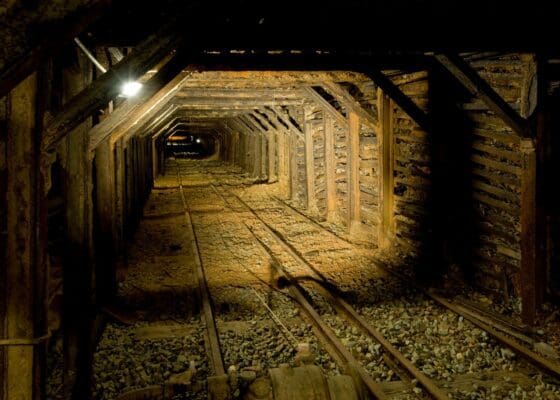

- Stewart Mine, Pala: Nestled in San Diego County, Stewart Mine is famously known for its pink tourmaline. Historically, these mines were so abundant that pink tourmalines from here were shipped to China for the Qing Dynasty. Located in Pala, the operating hours vary, mostly accommodating daylight times. The fees are determined based on the activity you choose, with options ranging from simple digging to specialized tours.
- OceanView Mine, Pala: Just a stone’s throw away from Stewart Mine, the OceanView Mine offers the chance to find not just tourmaline, but also kunzite, morganite, and many other gems. Open from 9 AM to 3 PM, fees here can range based on the prospecting activity and duration.
- Benitoite Gem Mine: A special spot in San Benito County, this is the only commercial mine where you can find benitoite, California’s state gem. Before heading out, it’s best to check the mine’s official website for hours and fee structures, as they occasionally change based on seasons and mining conditions.
- Himalaya Tourmaline Mine, Mesa Grande: Another gem of San Diego County, this mine is a major source of tourmaline for the past century. Regular digging days are available, typically starting in the morning and going till early afternoon. Fees are competitive and often include equipment rental.
- Roaring Camp Mining Company, Pine Grove: Not just gems but gold too! Roaring Camp, located in the heart of the Mother Lode, in Pine Grove, offers gold panning, sluicing, and more. It’s open daily during summer months, with varying hours in the off-season. The pricing depends on the chosen activities.
- Mojave Desert, San Bernardino County: Here, gem hunters can find fire agates, a beautiful form of chalcedony. While specific commercial operations might have set hours, many sites are open for public prospecting. Remember to check land ownership and regulations before digging.
- Cherokee Ruby Mine, Butte County: Located in the scenic forests of Butte County, this mine is known for its rubies and sapphires. The hours are generally from 9 AM to 6 PM during the season. Fees include equipment and vary based on age and group size.
- Calico Ghost Town, Yermo: While it’s more renowned for its silver mining history, Calico also offers gem mining for visitors. Open from 9 AM to 5 PM, there’s a nominal fee which covers both entry and basic gem hunting activities.
- Opal Hill Mine, Palo Verde: Situated near the southern border, this mine is famous for fire opals. The mining season typically runs from fall to spring, avoiding the scorching summer heat. Fees and hours can vary, so it’s advisable to contact the mine ahead of time.
- Lone Pine Gem and Mineral Society Claim: Situated in the picturesque Owens Valley, this site is beloved by rockhounds for its garnets and other minerals. While there isn’t a dedicated commercial operation, the local gem and mineral society organizes regular digs. Fees are minimal, often just covering administrative costs.
California’s gem mining sites offer an array of experiences, from the deserts of the south to the verdant northern forests. Whether you’re a seasoned rockhound or a family looking for a fun day out, these sites promise an adventure filled with discoveries.
History of Gem Mining in California
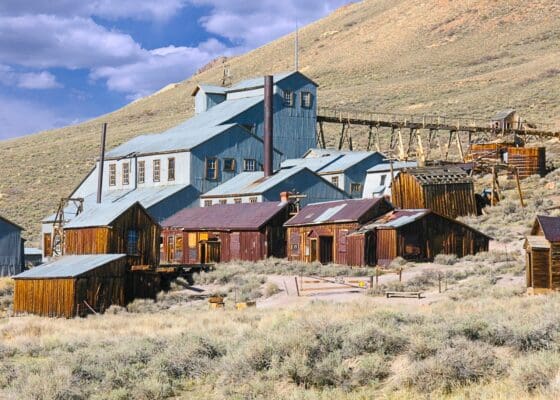

Gem mining in California, like its famous counterpart – the gold rush, has a rich and intricate history that spans over centuries. While tales of the Gold Rush of 1849 often overshadow other stories, gem mining, too, has had its own glittering chronicle that parallels the state’s development.
Long before European settlers made their way to the Golden State, Native American tribes like the Shasta, the Paiute, and the Ohlone were the first to recognize and utilize the region’s abundant mineral and gem resources. They crafted tools, weapons, and jewelry from materials such as obsidian, turquoise, and quartz.
The late 1800s and early 1900s marked significant milestones for gem mining in California. The discovery of tourmaline in San Diego County during this period is particularly noteworthy. It wasn’t merely a local sensation; these dazzling gems were highly esteemed on a global scale. In fact, the allure of the pink tourmalines from San Diego was so powerful that they caught the attention of the last empress of China, Empress Dowager Cixi. She became a fervent collector, which led to the California tourmaline boom. Mines like the Stewart Lithia and Himalaya became centers of bustling activity, shipping barrels of the gem to the Chinese court.
The early 20th century also witnessed the discovery of the state gem, benitoite, near the headwaters of the San Benito River. The striking blue crystals stood out uniquely, prompting an excited rush to lay claims and harvest this newly found treasure.
The Great Depression saw a slump in gem mining activities, but post-World War II brought about a resurgence. Amateur rockhounds began flocking to the state, forming clubs, and even organizing gem hunting excursions. The spirit of community and shared excitement rejuvenated the industry.
Today, while modern machinery and techniques have refined the process, the allure of discovering a hidden gem remains unchanged. Many of the mines that began operations over a century ago are still active, standing as testaments to California’s enduring mineral wealth and the persistent allure of its subterranean treasures.
Gem Mining Regulations in California


Gem hunting, like many other resource-based activities in California, is subject to a set of regulations designed to balance the excitement of discovery with the responsibility of preserving the state’s rich ecological and geological heritage. The tapestry of laws and guidelines ensures sustainable practices and safeguards the interests of both the land and its explorers.
- Land Ownership and Permissions: Understanding land ownership is crucial. Lands can be federal, state-owned, private, or Native American reservations. Each has its distinct rules:
- Federal Lands: While prospecting is allowed on most Bureau of Land Management (BLM) lands and national forests, certain areas may have restrictions or prohibitions, especially those designated as wilderness areas or national monuments.
- State-owned Lands: These might have more stringent rules, especially State Parks. Gem hunting may be restricted or prohibited altogether.
- Private Lands: Written permission from the landowner is a must before any prospecting can take place. Trespassing can lead to serious legal consequences.
- Native American Reservations: These lands are sovereign. Permission must be obtained from the respective tribal council, and often, gem hunting isn’t allowed.
- Collecting Limits: For those collecting on public lands, there are usually daily limits imposed on how much material a person can collect. This prevents over-extraction and ensures that there’s something left for future generations.
- Environmental Considerations: Miners should be environmentally conscious. All digging sites should be restored to their original state as much as possible. This means filling in holes, not diverting waterways, and adhering to Leave No Trace principles.
- Permits and Fees: Some areas require a permit for gem hunting. The costs vary based on the location and type of activity. For instance, while casual prospecting might be free in some BLM areas, commercial operations or usage of certain equipment might incur fees or require special permissions.
- Equipment Restrictions: Not all tools and machinery are allowed everywhere. In many areas, especially those ecologically sensitive, only hand tools are permitted. Larger equipment, like backhoes or sluice boxes, might be restricted to prevent significant landscape alterations and siltation of waterways.
- Selling and Commercial Activity: If one intends to sell the gems they find, they should be aware that commercial collection often falls under a different set of regulations, typically stricter, than recreational collection.
Understanding these regulations isn’t merely about adhering to the law – it’s about respecting the land that offers up its treasures. As stewards of the environment and beneficiaries of its bounties, gem hunters have a responsibility to mine ethically and sustainably, ensuring that California’s gem-rich landscapes continue to sparkle for generations to come.
Necessary Tools and Equipment for Gem Mining in California
The thrill of unearthing a gemstone lies not just in the discovery itself, but also in the process that leads to it. Just as a chef would require the right utensils or an artist the correct brush, a gem hunter needs the appropriate tools to enhance their experience and increase their chances of success. In the varied terrains of California, the right equipment can make all the difference between going home empty-handed or with a gem to cherish.
1. Screening and Classifying Tools: Reveal those hidden treasures!
Description: Sieves and screens are key to sifting through various materials. Stackable screens allow sorting by particle size, essential for smaller gems.


🛒 Explore Top Screening Sets on Amazon
2. Shovels and Trowels: Digging deep or just scratching the surface?
Description: Sturdy shovels are vital for deeper exploration, and trowels help with precision. Be eco-conscious in sensitive areas.


🛒 Find Quality Shovels and Trowels on Amazon
3. Picks and Hammers: Power and precision in every swing!
Description: Essential for prying stones and breaking rocks. The geologist’s pick is a gem hunter’s best friend.


🛒 Check Out Best Picks and Hammers on Amazon
4. Buckets: Your trusted companion for carrying treasures.
Description: Great for transporting soil or safeguarding your finds. Durability is key.
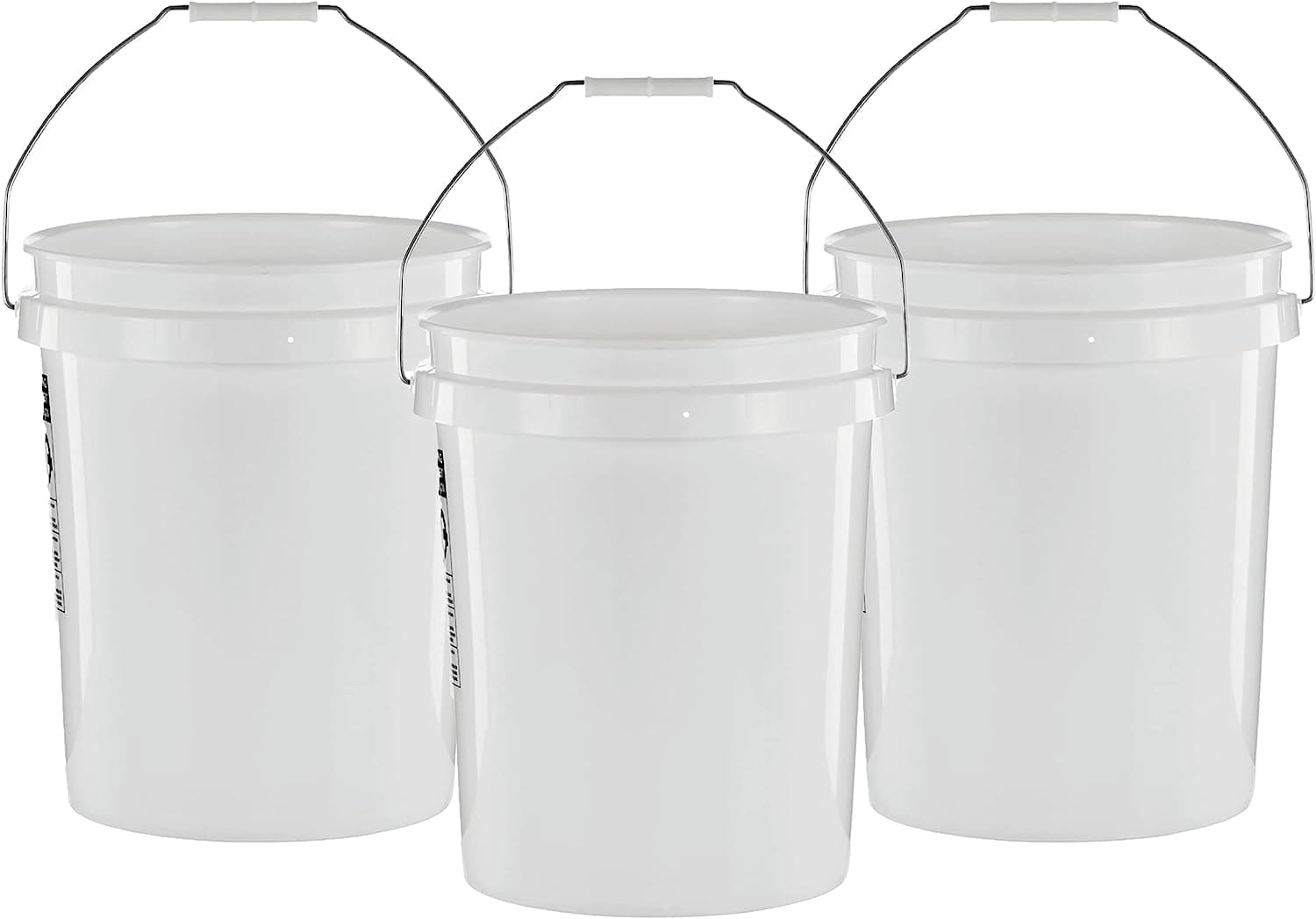

🛒 Shop for Reliable Buckets on Amazon
5. Magnifying Glass: Every detail counts!
Description: A magnifying glass magnifies the beauty and details of your finds.


🛒 Grab Your Magnifying Glass on Amazon
6. Guidebooks and Field Guides: Knowledge at your fingertips.
Description: Beginners or pros, a guidebook is priceless. Know your gems and their Californian homes.


🛒 Discover the Best Field Guides on Amazon
7. Containers and Bags: Organize, store, and flaunt your finds.
Description: Essential for storing gems. Pro tip: Labeling helps in tracking your gem-hunting journey.


🛒 Shop for Storage Solutions on Amazon
8. First Aid Kit: Better safe than sorry!
Description: Always be prepared for unexpected situations. A compact kit can be a lifesaver.


🛒 Secure Your First Aid Kit on Amazon
When venturing out in California’s diverse landscapes, from riverbeds to deserts, having the right tools can greatly enhance your gem hunting experience. They not only increase the likelihood of a successful find but also ensure that the process is both enjoyable and safe.
Tips and Tricks for Successful Gem Mining in California


Gem hunting in California, with its vast terrains and rich geological history, can be a rewarding endeavor. Yet, as any seasoned rockhound would attest, success often requires more than just the right tools. Here are some invaluable tips to enhance your chances of unearthing the state’s hidden jewels.
- Research Before You Head Out: Knowledge is a gem hunter’s best friend. Familiarize yourself with the area you plan to visit. Learn about its geological history, the types of rocks present, and the gems you might encounter. Local libraries, geological surveys, and even online forums can be great resources.
- Start Early: Many of California’s gem hunting sites, especially in the desert regions, can get incredibly hot as the day progresses. Beginning your search in the early morning can help you avoid the peak heat and make your hunt more comfortable.
- Follow the Water: In many regions, gems are carried downstream by water and accumulate in riverbeds, creeks, or along shores. Look for bends in rivers, natural traps, and depressions where heavier gemstones might settle.
- Know the Landscape: Gems often originate in specific rock types. For instance, pegmatite rocks often house tourmaline, while volcanic rocks can be a good place to hunt for opals. Recognizing these rocks can significantly narrow down your search area.
- Be Patient and Thorough: Gem hunting is as much about patience as it is about skill. Take your time to sift through the soil, screen the material methodically, and don’t be disheartened if you don’t strike luck immediately.
- Stay Safe: Always let someone know where you’re going, especially if heading to remote locations. Carry enough water, stay protected from the sun, and be wary of local wildlife.
- Engage with Local Communities: Local rockhounding clubs, gem shops, or even long-time residents can provide insights that might not be available in published materials. Their experience can guide you to lesser-known, fruitful locations.
- Respect the Land: Remember, the land is not just a source of gems but also an ecological habitat. Ensure you restore the area to its original state as much as possible after your hunt.
- Keep an Open Mind: While you might have a particular gem in mind, California’s lands are full of surprises. Sometimes, the most unexpected finds turn out to be the most rewarding.
- Document Your Finds: Keeping a journal of your gem hunting trips, complete with dates, locations, and descriptions of finds, can be a fulfilling exercise. It helps you track patterns, learn from previous trips, and refine your strategies.
Approached with patience, respect, and a sense of adventure, gem hunting in California can be an immensely satisfying pursuit, allowing you to not only discover the state’s geological wonders but also create lasting memories along the way.
Handling Your Gemstone Finds
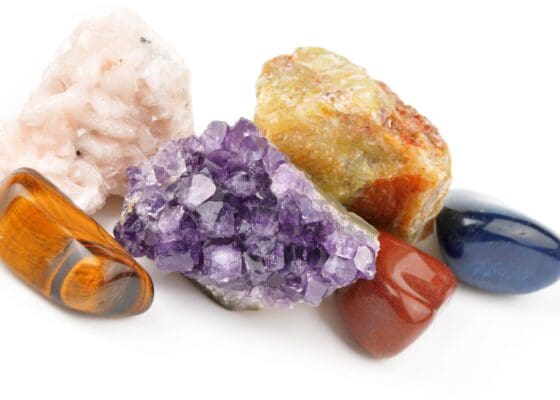

Once you’ve managed to unearth a gemstone, the journey has only just begun. Properly handling, cleaning, and preserving these treasures is essential, ensuring they remain as radiant and intact as the moment you discovered them. Here’s a guide on how to best care for your gemstone finds in California:
- Initial Cleaning: Once you’ve retrieved a gem, gently clean off the loose dirt using a soft brush. It’s crucial not to apply too much force, as some stones might be fragile or have inclusions that can be easily damaged.
- Soaking: For gems with more stubborn dirt or clay, consider soaking them in a container of water. This will help soften and dislodge the dirt, making the cleaning process gentler. Add a few drops of mild dish soap for better results. Ensure the gem is fully submerged and let it soak for several hours or even overnight, depending on the degree of dirt.
- Detailed Cleaning: After soaking, use a soft toothbrush to gently scrub the stone. Always use circular motions and ensure you reach every nook and cranny. For extremely fine details or crevices, consider using a toothpick or a soft-tipped tool.
- Drying: Once cleaned, pat the gemstone dry with a soft cloth. It’s advisable to let it air dry further to ensure no moisture remains, which could potentially damage the gem or promote fungal growth.
- Storage: Store your gemstones separately in soft cloth bags or padded boxes. This prevents them from scratching one another. For particularly soft or fragile gems, consider wrapping them in a soft cloth before placing them in a container.
- Identification: If you’re unsure about the identity of your find, consider taking it to a local gemologist or a gem club. They can provide insights into the gem’s type, quality, and potential value.
- Documentation: Always keep a record of where and when you found each gem. This not only adds to its story but can also be valuable if you decide to sell or showcase your collection.
- Valuation: For gems you believe might be of significant value, consider getting them appraised by a certified gemologist. They can provide a detailed report on the gem’s quality, origin, and market value.
- Display: If you’re keen on displaying your finds, invest in quality display cases that protect against dust, moisture, and direct sunlight.
- Maintenance: Periodically check your collection for signs of damage or degradation. Some gems can be sensitive to humidity, temperature changes, or even prolonged exposure to light.
Handling gemstones with care and reverence not only preserves their natural beauty but also ensures that they remain a cherished part of your collection for years to come, serving as tangible mementos of your adventures in the Golden State.
Famous Gemstone Finds in California
California, with its rich geological tapestry, has been the birthplace of countless tales of dazzling gemstone discoveries. These storied finds not only illuminate the state’s abundant natural wealth but also have, over time, woven themselves into the fabric of California’s cultural and historical narrative. Let’s delve into some of the most remarkable gemstone discoveries that have left an indelible mark on the Golden State:
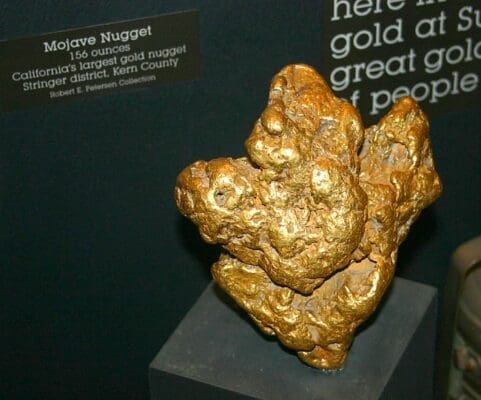

- The Mojave Nugget: Discovered in 1977 in the Stringer District near Randsburg, California, this is the largest known naturally occurring gold nugget in California, weighing in at an astonishing 156 troy ounces. Its discovery underlined the state’s legendary reputation in the annals of gold mining.
- The Pink Star of San Diego: Unearthed in the renowned gem mines of San Diego County, this pink tourmaline, weighing over 400 carats, is among the world’s largest of its kind. San Diego’s mines have long been famous for their exquisite pink and green tourmalines.
- The Cullinan Blue Diamond: Originating from the depths of California’s mines, this diamond, named in homage to the iconic Cullinan Diamond, dazzles with its rich blue hue. Its discovery reaffirmed California as a hub for diverse gemstones beyond gold.
- The Goliath Garnet: Found nestled in the Sierra Nevada Mountains, this record-setting almandine garnet weighed over 9,000 carats. The garnet’s sheer size and pristine quality make it a marvel of California’s mineralogical bounty.
- The Centennial Benitoite: Celebrating California’s centennial, this spectacular blue gem, weighing 15.42 carats, is the largest known cut benitoite, the state gem of California. Discovered in the remote Diablo Range, its unveiling was a testament to the region’s unique geology.
- The Jade Coast Treasures: Stretching along the coastline of Big Sur, this region has yielded numerous nephrite jade specimens, some weighing hundreds of pounds. They serve as a reminder of California’s rich marine geological formations.
- The Neptunite Black Star: Extracted from the depths of San Benito County, this stunning black gem, with its star-shaped cross-section, is not just a marvel to behold but also highlights the area’s unique mantle-derived rocks.
- The Fricot Nugget: Weighing 13.8 pounds, this is the largest crystalline gold nugget still in existence from California’s Gold Rush era. Discovered in 1865, it serves as a glistening relic of a bygone era of gold fever and exploration.
These tales of discovery, while highlighting the state’s vast geological wealth, also underscore the spirit of exploration, perseverance, and wonder that has always defined California’s gem hunters. Each find, whether monumental in size or unmatched in quality, adds a shimmering chapter to California’s illustrious gemstone legacy.
Additional Gem Mining Opportunities
Venturing beyond California’s borders, neighboring states also beckon with their unique geology and promise of gemstone discoveries. Here’s a glimpse into what these states have to offer:
- Nevada Gem Mining: Often termed the “Silver State” due to its rich silver deposits, Nevada also boasts a variety of gemstones, including turquoise, garnets, and opals, especially in areas like the Virgin Valley.
- Oregon Gem Mining: The Pacific Northwest gem that is Oregon showcases a myriad of treasures from sunstones in the Plush region to the fascinating thundereggs scattered across the state.
- Arizona Gem Mining: Known as a major copper-producing state, Arizona’s mineral wealth extends to peridot, amethyst, and the globally renowned turquoise from the Kingman and Morenci mines.
- Utah Gem Mining: Aptly named the “Beehive State”, Utah is a hive of geological wonders. From the fiery red beryl to topaz and variscite, the state is a rockhound’s paradise.
- Baja California (Mexico) Gem Mining: While technically not a U.S. state, this neighboring region shares the peninsular geography with California. Renowned for its pink calcite and other minerals, it’s a worthy extension for gem enthusiasts exploring beyond California.
These states, each with its distinct geological characteristics, present a continuum of gem hunting opportunities, enriching the tapestry of North America’s mineralogical diversity.
Dive into the world of gem mining with our extensive Gem Mining Near Me guide for top tips and locations.
The Lure of California Gems and At-Home Adventures
The pursuit of gem hunting in California is more than just a quest for sparkling treasures; it’s a journey through the state’s intricate tapestry of geology, history, and natural beauty. From the rugged terrains of the Sierra Nevada Mountains to the sun-drenched stretches of the Mojave Desert, each region unfurls its unique array of gemstones, ready to captivate the heart of every adventurer.
Yet, while the thrill of discovery in California’s wilds is unparalleled, not everyone has the luxury to venture into these terrains. Enter the Gem Mining Kit – a compact treasure chest that brings the excitement of gem hunting right into your home. Packed with a mix of authentic gemstones this kit offers a delightful alternative for those yearning to experience the wonder of gem discovery, all from the comfort of their living room. It’s the perfect blend of education, fun, and a taste of California’s illustrious gem-rich legacy.

